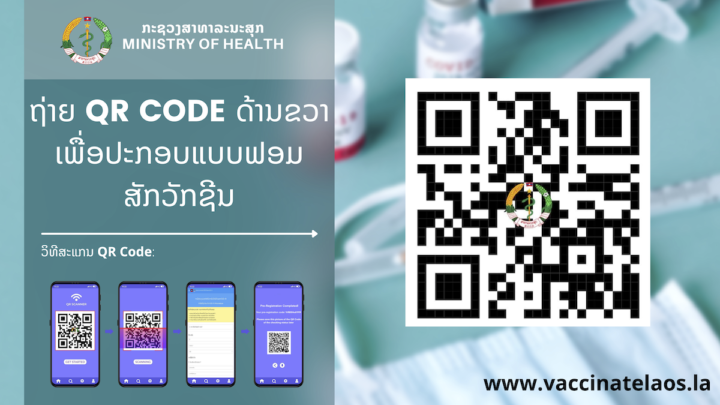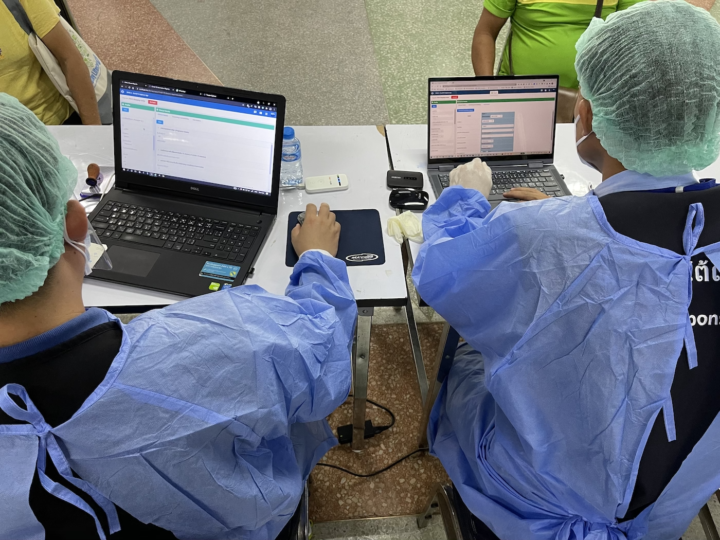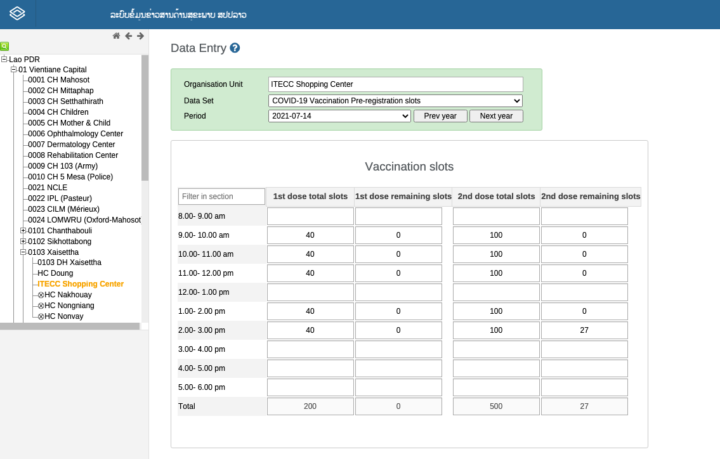Cette page a été traduite automatiquement et pourrait contenir des erreurs
Paramétrage de DHIS2 avec des apps paramétrées pour une surveillance et une vaccination efficaces contre le COVID-19 au Laos
Avec le soutien du HISP Vietnam, la RDP Lao a déployé des solutions numériques pour le suivi du traitement des patients atteints de coronavirus, l’auto-enregistrement des vaccins COVID-19 et la vérification sécurisée du statut des vaccins.
Lorsque la pandémie de coronavirus a été déclarée début 2020, le Laos (Lao PDR) a été l’un des premiers pays au monde à déployer la collection de métadonnées de surveillance DHIS2 COVID-19 pour surveiller la propagation de cette nouvelle maladie. Depuis qu’il a soutenu le lancement initial de la plateforme, le HISP Vietnam a travaillé avec le ministère de la Santé du Laos pour affiner et étendre le système, y compris le développement d’applications paramétrées pour le suivi du traitement des patients atteints de coronavirus et la réalisation de la recherche des contacts.

Lorsque les vaccins sont devenus disponibles en 2021, le HISP Vietnam a également aidé le Laos à déployer le vaccin contre la grippe aviaire. DHIS2 Livraison du vaccin COVID-19 qu’ils ont ensuite paramétré pour y inclure des apps d’auto-inscription aux rendez-vous de vaccination et de saisie simplifiée des données dans les centres de vaccination, ainsi que la génération de QR codes sécurisés au sein de l’application. Tracker qui peuvent être utilisés pour produire des certificats de vaccination vérifiables. À la mi-2021, le Laos avait utilisé ce système DHIS2 pour planifier et enregistrer près de deux millions de doses de vaccin COVID-19, et continue d’utiliser DHIS2 pour suivre les nouvelles infections, retrouver les contacts et surveiller le traitement des patients atteints de coronavirus.

Extension des paquets standard COVID-19 pour la recherche de contacts, la surveillance des patients et la gestion des lits d’unité de soins intensifs
Le système DHIS2 déployé par le Laos au début de la pandémie de COVID-19 était basé sur le programme de surveillance standard de l’OMS, traduit en lao et adapté au contexte local. Au fur et à mesure de l’apparition de besoins et d’exigences supplémentaires, le HISP Vietnam a travaillé avec le ministère de la santé du Laos et les membres de l’équipe de l’OMS LAO pour identifier et concevoir des solutions. L’un des besoins immédiats était la recherche de contacts. Le HISP Vietnam a développé une application personnalisée dans DHIS2 pour la recherche des contacts qui a facilité le lien entre les cas positifs enregistrés dans Tracker et leurs contacts (qui ont été saisis dans un programme Tracker distinct et liés à l’aide d’attributs). En outre, un tableau de bord paramétré a permis aux agents de santé de visualiser leurs activités de recherche de contacts, notamment à l’aide d’une carte de surveillance des cas.
Dans les centres de santé et les hôpitaux, les travailleurs de la santé qui fournissent des traitements aux patients atteints de coronavirus ont bénéficié d’une application web paramétrée développée par le HISP Vietnam qui a rationalisé et simplifié leur processus de saisie des données. En utilisant une tablette pour scanner un code QR unique généré dans Tracker pour chaque patient, ils pouvaient immédiatement accéder au dossier du patient et mettre à jour les informations en fonction des activités de traitement quotidiennes et des résultats de santé, tels que le transfert vers un autre établissement ou la sortie. Parce que la conception de cette appli a été basée sur le flux de travail des agents de santé au Laos – et qu’elle omet toute information de l’interface standard de Tracker qui n’est pas nécessaire à leur travail – elle leur permet d’enregistrer leurs observations quotidiennes en 10 secondes par patient ou moins. Toutes les mises à jour effectuées dans cette appli sont synchronisées avec le système Tracker, ce qui permet un suivi en temps réel au niveau du district et au niveau national.

Outre le suivi des résultats des traitements, les autorités sanitaires du Laos ont également demandé des outils supplémentaires pour la planification et le suivi de la capacité du système de santé à traiter les patients atteints de coronavirus. À cette fin, le HISP Vietnam a ajouté au DHIS2 un ensemble de données agrégées sur la disponibilité des lits de soins intensifs, dans lequel chaque hôpital peut entrer les chiffres quotidiens des lits occupés et disponibles, ce qui permet aux fonctionnaires du ministère de la santé de disposer d’informations actualisées sur la capacité du système sanitaire et aide les responsables de la santé à déterminer où envoyer les nouveaux patients pour qu’ils reçoivent un traitement.
Utilisation de Tracker pour la planification de la campagne de vaccination COVID-19, plus une application web conviviale pour l’auto-enregistrement des rendez-vous de vaccination.
Comme pour la surveillance du COVID-19, le Laos a commencé sa mise-en-œvre du DHIS2 pour la livraison du vaccin COVID-19 avec la collection de métadonnées standard du DHIS2, sur la base des orientations de l’OMS. Compte tenu de l’offre limitée de vaccins, les autorités sanitaires du Laos ont décidé de diviser la première phase de leur campagne de vaccination en groupes prioritaires, tels que les travailleurs de la santé, les personnes âgées de plus de 60 ans, les personnes souffrant de troubles médicaux sous-jacents, etc. HISP Vietnam a aidé à modifier le module Tracker dans DHIS2 pour inclure ces catégories et a configuré des tableaux de bord pour montrer le statut de vaccination de chaque groupe en temps réel, et a ajouté un rapport agrégé quotidien qui pourrait compléter les données Tracker selon les besoins.
Au fur et à mesure de la sensibilisation du public et du lancement de la campagne de vaccination, il est apparu que la charge de saisie des données pesant sur les agents de santé dans les centres de vaccination était trop importante, puisqu’ils devaient remplir les données personnelles de chaque patient en Tracker pour chaque rendez-vous. Pour y remédier, le HISP Vietnam a conçu un portail web public où les gens peuvent sélectionner une liste d’établissements de santé avec des rendez-vous de vaccination disponibles, s’inscrire pour un rendez-vous à une heure spécifique, et recevoir un code QR avec leur confirmation de rendez-vous. Grâce au portail web, le HISP Vietnam peut paramétrer la logique selon les recommandations du ministère de la santé et de l’OMS afin de réserver les rendez-vous limités pour les vaccins uniquement aux groupes prioritaires. Cela permet de réduire les foules qui ne figurent pas sur la liste cible des sites de vaccination.

Lorsqu’ils arrivent au centre de vaccination, l’agent de santé scanne le code QR qui ouvre le dossier du patient dans une appli de vaccination paramétrée, où l’agent de santé vérifie que les informations du patient sont correctes, et met à jour le dossier avec le type spécifique de dose de vaccin administrée. Ces innovations ont considérablement rationalisé le flux de travail dans les centres de vaccination, ce qui a permis à certains d’entre eux de distribuer plus de 2 000 vaccins par jour au plus fort de la campagne, et d’accroître la flexibilité et la transparence du processus pour le public.

Ces deux applications paramétrées ont été conçues par le HISP Vietnam comme des applications web progressives au-dessus de DHIS2 Tracker. Cela signifie qu’aucune base de données supplémentaire n’est nécessaire en amont : Toutes les informations affichées et enregistrées à la fois par les applis d’auto-inscription et de vaccination sont stockées directement dans le DHIS2 – le statut vaccinal du patient et les détails du rendez-vous sont liés à son dossier individuel dans Tracker, tandis que la disponibilité des rendez-vous vaccinaux est maintenue dans un ensemble de données agrégées quotidiennes pour chaque centre de vaccination qui leur permet de spécifier le nombre de rendez-vous disponibles par catégorie de priorité et par type de vaccin.

En plus d’être plus efficaces, ces applications sont également plus sûres, car elles tirent parti des fonctions intégrées du DHIS2 en matière de sécurité des données et de respect de la vie privée. Le fait de disposer d’un dossier principal pour chaque patient dans DHIS2, auquel différentes équipes du ministère de la santé peuvent accéder en toute sécurité, facilite également les activités de suivi, telles que l’enregistrement et l’examen d’éventuels problèmes de santé publique. Effets indésirables consécutifs à la vaccination (AEFI)et permet aux patients de vérifier leur statut actuel directement sur le portail web public.
Utillisation de DHIS2 pour générer des codes QR sécurisés pour le statut des vaccins, conçus pour un lien potentiel avec les passeports vaccinaux et d’autres solutions de certificats numériques.
À la fin du mois de juillet 2021, le ministère de la santé avait réalisé des progrès significatifs dans la vaccination de la population du Laos, avec plus d’un million de personnes vaccinées avec une dose, dont 800 000 avaient déjà reçu leur deuxième dose. Pour fournir aux autorités du Laos un moyen sécurisé de vérifier le statut vaccinal de la population du pays, HISP Vietnam a configuré une solution au sein de Tracker, en ajoutant une nouvelle étape de programme pour générer un code QR pouvant faire office de certificat de vaccination. Alors que d’autres pays ont déjà mis-en-œvre des solutions similaires en utilisant le DHIS2, la particularité du travail du HISP Vietnam est qu’il a été conçu dès le départ pour répondre aux exigences et aux normes d’encodage comme l’utillisation de DHIS2. Certificat numérique COVID de l’UE (DCC), également connu sous le nom de certificat vert numérique, qui facilite l’intégration potentielle avec cette solution, ainsi qu’avec d’autres, comme l’application CommonPass des États-Unis, qui fonctionnent sur la base de normes ouvertes.
À l’heure où les sociétés du monde entier commencent à s’ouvrir à nouveau, et où certaines régions assouplissent les restrictions imposées aux voyageurs vaccinés, cette innovation du HISP Vietnam pourrait profiter à de nombreux pays qui utilisent DHIS2 pour leur registre électronique des vaccinations (EIR) COVID-19. Bien que cette technologie de code QR ne soit utilisée en interne qu’au Laos pour le moment, HISP Vietnam travaille sur des déploiements pilotes de certificats numériques COVID utilisant la même technologie dans d’autres pays où il fournit une assistance à la mise-en-œvre du DHIS2, tels que le Vanuatu et les Îles Salomon.
Le succès du déploiement repose sur l’expérience acquise avec DHIS2 et l’expertise régionale, et jette les bases des améliorations futures.
Le succès du Laos dans le déploiement du DHIS2 pour la réponse au COVID-19 est dû à la combinaison de la capacité et de l’expérience locales et du soutien du réseau HISP. Le Laos utilise le DHIS2 comme système d’information sanitaire (SGIS) au niveau national depuis 2015. Ces dernières années, le ministère de la santé lao a également déployé DHIS2 pour des programmes de santé clés – notamment le VIH, le paludisme et la tuberculose – en utilisant des collections de métadonnées DHIS2 standardisées développées par l’HISP UiO en collaboration avec l’OMS. Le HISP Vietnam a soutenu le Laos dans la mise-en-œvre de ces systèmes, a aidé à les paramétrer en fonction du contexte local et a assuré la formation du personnel du ministère de la santé en matière de renforcement des capacités. Grâce à cette expérience préalable et à l’historique de la collaboration, ainsi qu’à la possibilité de partager la hiérarchie des unités d’organisation du Laos et d’autres données clés du SGIS avec le nouveau système COVID, les autorités sanitaires du Laos et du HISP Vietnam ont pu rapidement déployer le DHIS2 pour contribuer à la résolution de la crise du COVID-19.
En attendant, l’expérience acquise par le Laos au cours de la réponse au COVID-19 peut être mise à profit pour améliorer le système d’information au-delà de la pandémie. Par exemple, l’équipe nationale de vaccination au Laos avait déjà utilisé des données agrégées et des données d’événements dans le cadre de l’enquête sur la vaccination. DHIS2 pour la gestion des programmes de vaccination. Après l’utilisation réussie de Tracker pour la vaccination contre le COVID-19, ils prévoient maintenant de déployer Tracker pour la gestion basée sur les cas d’autres programmes de vaccination, et peuvent tirer les leçons et les innovations du coronavirus et les appliquer aux futures campagnes de vaccination.
Regardez une visite vidéo d’un site de vaccination COVID-19 au Laos pour voir le système DHIS2 Tracker en action.



